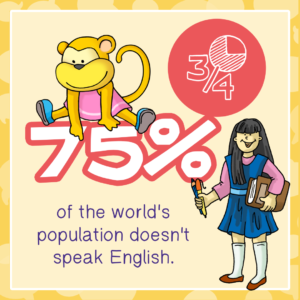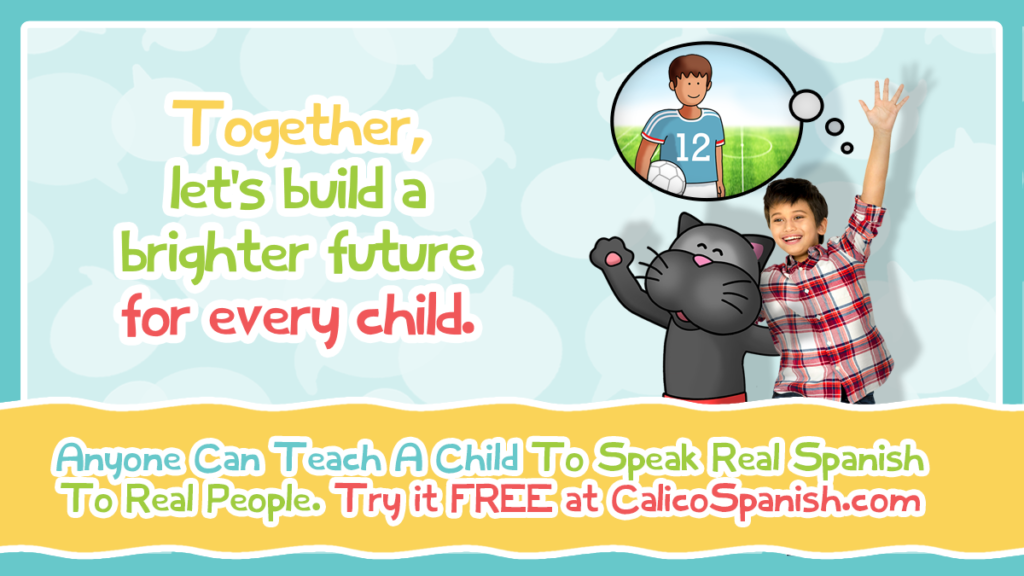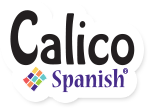10 Reasons Children Should Learn Spanish
10 Reasons Children Should Learn Spanish
In the technology-enhanced reality of today, let’s ask a question:
Is learning Spanish really a big deal?
Here at Calico Spanish, we would like to answer with a different question:
What does the future hold for the children you know and love?

The answer, of course, is a resounding “We don’t know.” We don’t know where the children in our lives will end up. Where will their talents and passions take them? What will they change, improve, revolutionize?
– Follow us on Twitter –
But something else is equally true. There are things we do know about the world that help us make decisions now to impact our children’s future. What we know about the human body helps us shape their food choices. What we know about the environment helps us train them to conserve and protect.
And with what we know about our interconnected, linguistically diverse world and country, we know that learning Spanish really matters. It matters a lot. And it can change a child’s life. We’ve put together this infographic for two reasons. First, we can better understand why every child should have the opportunity to learn Spanish. Second, we should all advocate for more Spanish learning opportunities in our schools by sharing this information.
– Like Calico Spanish on Facebook –
We create curriculum anyone can use to teach young children to speak Spanish. Try it free TODAY.
The world is waiting for children to learn Spanish!
Yes, learning Spanish in elementary school can boost kids’ brain power, and yes, it absolutely will change their job prospects (keep reading), but our favorite reason for learning Spanish is simple: friends.
– Follow us on Instagram too! –
Around the world, 75% of the global population does not speak English – that’s Fact #1. What’s the fastest way to open up opportunities to make friends with the 3 out of 4 world citizens who does not speak English? Start learning a new language!
You don’t have to leave the U.S. to find out why learning Spanish is important, though. 65 million (Fact #2) U.S. residents speak a language other than English, and Spanish is by far the most common language spoken among these potential friends.

Children are not learning Spanish in U.S Elementary Schools
Fact #3: We know that learning languages comes more naturally and easily to a child’s brain. Children should start learning language before age 10. Older kids and adults can still learn Spanish, of course, but they are much less likely to be able to speak the language very well.
But a little research reveals an abysmal truth: elementary programs in the United States are failing to provide children with the Spanish experience they need and deserve. Right now, only 1 in 4 elementary schools in the U.S. is offering a world language (Fact #4). Here’s Fact #5 and note that this is from kindergarten through 12th grade: 4 out of 5 kids have no opportunity to learn a language at school.
If you know of an elementary school who is on the fence about offering the opportunity for children to learn Spanish, we invite you to send them this blog post and infographic!
Fact #6: You probably know that learning multiple languages is much more common across the globe than in the U.S. Did you know that 7 European countries can boast that 100% of their schoolchildren are learning another language? Fact #7: To summarize a Pew research analysis,
The U.S. could triple enrollment tomorrow and it would still be the worst of any country in the survey.
What can you do? Start advocating at your child’s school for language learning. Send this post to principals, school boards, teachers, curriculum specialists – any decision maker who needs to see the start reality of how English-centered American education is short-changing our kids. And if the school won’t help, remember you can do it at home with Calico Spanish Stories. (Check out options for at-home learning here.)
Future employers need children to learn Spanish.
A few weeks ago I was at a Verizon store lounging while my husband was shopping for a new phone. My Spanish-teacher heart was certainly gratified to hear a young man adeptly navigate helping a Hispanic couple with their phone purchase in quite proficient -but not native- Spanish. After they left, he told me that the Verizon stores across our (very diverse) city send their Spanish speakers to this store.
It’s like, the Spanish store,
he joked. This young man and one other employee there speak proficient Spanish, so other stores know they can send Spanish speakers there to be helped. He also told me that this couple was from Nicaragua, where he had visited a couple of years ago. He said they had not been back in a long time, and it was sweet to connect over this shared piece of their experience. (Remember: relationships matter, and in our opinion, they matter most here.)
Here’s a good point: You know who has some serious job security and standing on which to ask for raises, benefits, and accommodations in scheduling hours? That guy does.
Another quick story: A friend of mine, a longtime travel agent, recently decided to change companies. In her interview with the new employer, she wanted to negotiate for higher pay. The prospective boss asked,
Do you speak Spanish?
My friend doesn’t, but out of curiosity, she responded,
Why, what would that get me?
The response?
Twenty thousand dollars.
I don’t know about you, but where I come from, $20,000 more a year is a whole lot of breathing room in my budget.
Fact #8: We know that 85% of their future employers need children to learn Spanish ASAP. That surpasses by far the next most-needed language. Between 2010 and 2015, job postings for bilingual workers increased by 262% (Fact #9). And in an important survey (Fact #10!), 56% of employers reported that they believed their need for language-skilled employees would increase over the next five years. Employers should be advocating for children to learn Spanish at a young age to better improve our job market and help others in the community communicate their wants and needs.
With Calico Spanish Stories, the children will learn Spanish today. Then they’ll soar tomorrow. Try it free NOW.
3 days a week builds a bright tomorrow.
At Calico Spanish, we say it and write it and proclaim it: Anyone can teach a young child to speak Spanish. And children who are learning Spanish can change the world. But without the right resources, helping children learn Spanish can feel impossible.
Not anymore. We invite you to try the most comprehensive, user-friendly Spanish program available for children everywhere. Just click here to see the first full lesson, and then sign up for a 7-day free trial.
With four levels and more than 360 step-by-step lesson plans, a parent or teacher can work through three lessons a week to make a real difference in a child’s Spanish proficiency. Don’t take our word for it. Listen to this unsolicited feedback from how the program worked for these customers:
Calico Spanish saves me hours of work by providing teaching materials that are age appropriate and tailored to meet the needs of all my students.
The girls love watching the videos and listening to the songs. They will play Spanish class with their dolls and their young cousins.
My daughter is now able to speak, read and understand simple Spanish stories, with completely new vocabulary.
They tried to sing the songs from the first day and they are never tired to watch them over and over!
My students feel so successful with their comprehension! I do a lot with movement and I just love how they come alive when they hear the vocabulary in a different context.
They even asked to do Spanish on their day off from school!
The videos are great. Now when we’re watching them the kids try to guess what the words mean before we learn them. They’re usually right!
My daughter learned so much using Calico. Thanks to Calico, she can now read Spanish children’s books!
What are you waiting for? Their story can be your story. Together, let’s build a brighter future for every child.
Try Calico Spanish Stories FREE.
Sources:
- Making Languages our Business, a survey report commissioned by the American Council on the Teaching of Foreign Languages (ACTFL)
- “Advantages of a Bilingual Brain,” Michigan State University
- “Bilingual Babies: Study Shows How Exposure to a Foreign Language Ignites Infants’ Learning,” University of Washington
- “Not Lost in Translation: U.S. Jobs Market Needs Foreign Language Skills,” New American Economy Research Fund
- “Foreign Language Classes Becoming More Scarce,” American Academy of Arts & Sciences
- “Most European Students Are Learning a Foreign Language in School While Americans Lag,” Pew Research Center








4 Comments
I would greatly appreciate it if you would send me the poster ” Why does every child need Spanish?” I am entering into my second year of teaching elementary students K-5th and would like to present this crucial information during our BACK To SCHOOL program. It’s challenging with the majority NOT believing that Spanish is as crucial as proclaimed. My school (Bethlehem Elem@ 1000 Academic Pkwy. Locust Grove, Ga 30248) is currently utilizing the Calico Curriculum. Thank you in advance for providing this material.
Good afternoon, Ms. Williams! I’ll share this poster with you via email!
I have been using Calico Spanish for three years with my primary grade students We have class only twice a week but they enjoy the stories. I have seen a better success in their comprehension and usage of Spanish compared to my previous classes.
Please send me the poster so I can share these facts with the families as they return to school. Unfortunately there are people who feel learning a language other than English is a waste of time.
¡Muchísimas gracias!
Ms. Strackeljahn, I’ll share this poster with you via email. I love hearing that your students enjoy the stories and that you’re seeing improvement in comprehension and usage of Spanish! Thank you for sharing!